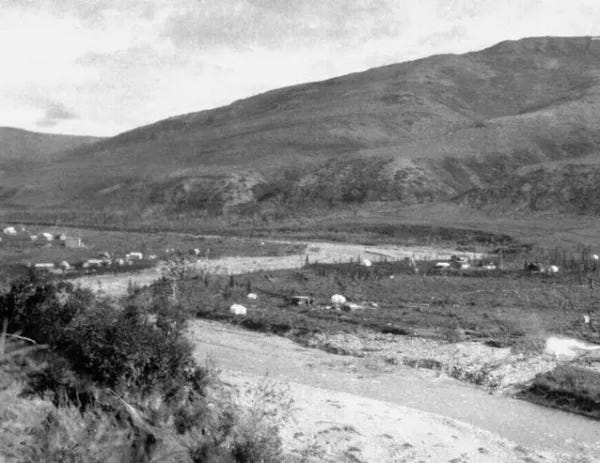Alaskan Roadhouses: Shelter, Food and Lodging Along Alaska’s Roads and Trails, by Helen Hegener, was published by Northern Light Media in 2016. The 284-page book presents historic photos of dozens of individual roadhouses, along with first-hand accounts of those who stayed at the roadhouses while traveling the early trails and roads of Alaska. The Kantishna Roadhouse, originally known as the Eureka Roadhouse, was located near the end of the Park Road, and it is the oldest standing building in Denali National Park and Preserve.

The location of the Eureka Roadhouse in the photo above is recorded as Kantishna, Denali National Park and Preserve, McKinley Park Region, Interior Alaska. No date is given, but photographer William R. Norton’s collection is dated between 1890 and 1920, and the National Park Service gives a construction date for the roadhouse between 1919 and 1920.
The gold mining camp of Kantishna was founded in 1905, and like many such camps, was originally called by the popular gold rush name “Eureka.” On the north side of Mt. McKinley, with an elevation of 1,696 feet, Kantishna was in the Kantishna Hills at the junction of Eureka Creek and Moose Creek, three miles north and west of scenic Wonder Lake. Several such camps sprouted with the discovery of gold in the area in 1904, but the settlement which would become known as Kantishna was located closest to the gold-producing creeks. As the nearby gold camps were abandoned, those who stayed in the area migrated to Kantishna, and a post office by that name was established in 1905, officially changing the name of the community.

The Kantishna stampede was the result of relatively simultaneous gold discoveries by Joe Dalton on Eureka Creek and Joe Quigley on Glacier Creek. News of these discoveries in June of 1905 brought thousands of prospectors into the area. Towns such as Diamond, Glacier City, and Roosevelt were quickly established as supply points along the northern river routes used by the stampeders to reach the gold fields of the Kantishna Hills, and in very short order most of the creeks in the Kantishna Hills were staked their entire length.
In 1919-20, C. Herbert Wilson became Kantishna’s commissioner, and he constructed the two-story log building which would become the Kantishna roadhouse as a residence for his family. Over the years, the large structure became a focal point of the community, serving as the post office, commissioner’s office, a community gathering spot and a place for travelers to spend the night. The historic Kantishna Roadhouse still stands on its original site, while nearby is the modern facility and popular tourist destination of the same name.
For more information:
• Kantishna Roadhouse (National Park Service)
• Kantishna Gold! (National Park Service)
• Snapshots from the Past: A Roadside History of Denali National Park and Preserve, by Jane Bryant (NPS, US Dept. of the Interior, 2011)
• Kantishna Hills Pioneers, 30 minute documentary, free to watch online
• Kantishna—Mushers, Miners, Mountaineers, The Pioneer Story Behind Mount McKinley National Park, by Tom Walker (Pictorial Histories Publishing, 2006)
• Kantishna at Wikipedia
• Fannie Quigley, longtime Kantishna resident
Excerpted from "Alaskan Roadhouses, Shelter, Food, and Lodging Along Alaska's Roads and Trails," by Helen Hegener, published by Northern Light Media in 2016. 6" x 9", over 100 black/white photographs, 284 pages. $24.95 plus $5.00 for First Class shipping.






